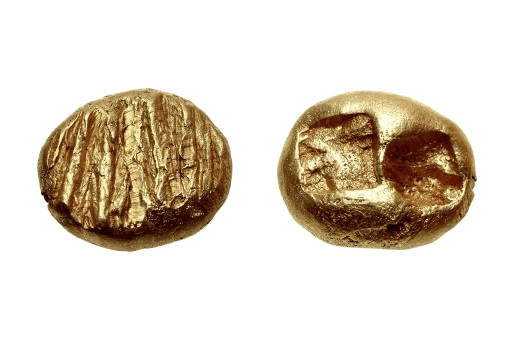
about ancient nomos
Ancient Nomos Art is a museum of galleries exhibiting ancient coins and ancient mint maps. The coin gallery displays the diverse art and history of hand-crafted ancient Greek, Roman, Byzantine, Persian and Medieval coinage. The ancient mints mapping gallery features Greek, Roman, Byzantine, Asia Minor and Medieval mint city regions and territories. Visitor's are welcome to explore, study and enjoy Ancient Nomos Art.

Greek, Ionia – 650 BC
Ionian Hekte
From Ancient Galleries

Obverse: Two flattened (nearly parallel) striated surfaces.
Reverse: Two (independently hammered) incuse punched squares.
LEGEND SYMBOLS
Obv: Two flattened (nearly parallel) striated surfaces. Rev: Two (independently hammered) incuse punched squares.
The ancient Greek region of Ionia, located on the western coast of Asia Minor, is considered by many to be the origin of ancient coins. The coin above, known as an electrum (mix of gold and silver), is considered to be the earliest known coin, about 2,665 years old. This small coin, called “white gold” (Λενκός χρνσός – Herodotus 1.50.2) by ancient Greeks, is the first monetary unit used by humans as a means of exchange. During the last century, a small hoard of these coins was excavated from under the ancient foundation structure of the Artemis Temple in Ephesos. Many believe the coins were minted between 650 and 630 BC, since Artemis was built after 630 BC. This particular piece shown is known as a striated electrum coin, due to the somewhat parallel lines impressed on its flattened surface. A square punching tool was used to impress two square voids into the opposite side. The planchet of electrum metal was hammered (struck) while the blank coin rested on an iron anvil-like surface. The iron anvil was pre-gouged or engraved with striated lines so as to emboss the planchet after the ancient mint workers hammered a square impression into the upward coin face. One will notice the above coin was hammered twice, resulting in two square impressions side by side. The double strike can also be evidenced by the two slightly shifted flat surfaces on the striated side. Numismatists remain puzzled over the rationale or thought process behind both the striated and punched surfaces on these coins. Some believe the striations may allude to a metaphorical image, perhaps something found in nature. A more practical explanation suggests that a striated striking surface likely served the purpose of preventing the rounded ball-shaped planchet of metal from slipping of the anvil when struck or punched. The square punched or incused image may have served as a kind of counter mark, serving to indicate the coin was legitimate “legal tender” and possibly state sanctioned. Perhaps the two punched voids allowed one to verify the coin was solid electrum by visually seeing into its core. As mentioned, the term electrum is used to define this naturally occurring ore, a mix of approximately 50% gold and 50% silver. We know that the percentages or ratio of gold to silver in this natural metal ore was not precise. However, the ancient Ionian’s used a precise theory of economics to carefully calibrate each coin’s weight, by constructing very accurate divisions and denominations, right down to the hundredth of grams. The above coin has a denomination called a hekte, the ancient equivalent of 1/6 stater, and weighs 2.4 grams. Eight standard denominations are known to have circulated and include the following; 14.4 gram stater, 7.2 gram hemistater (1/2 stater), 4.8 gram trite (1/3 stater), 2.4 gram hekte coin above (1/6 stater), 1.2 gram hemihekte (1/12 stater), 0.6 gram myshemihekte (1/24 stater). In addition, a 1/48 stater and 1/96 stater also exists. Lesser denominations have been discovered, but are very rare. Many numismatic scholars believe the early electrum coinage was too overvalued for ordinary purchases or small transactions. Current thinking suggests these tiny pieces of “white gold” were used as a valuable financial tool or instrument to service large mercantile transactions, as payment for government expenses, exchange for large quantities of goods, and perhaps as a king’s offering during a religious ceremony. Nevertheless, the electrum coinage of Asia Minor is considered a major historical invention, flourishing for nearly 100 years before humans learned how to separate gold and silver.
NOTE:
According to Alan Bresson, the earliest Ionian electrum coinage metal was likely not a naturally occurring alloy found in the local environs, but rather was in fact a man-made product intentionally mixed to create a unique gold and silver alloy with its own unique and intrinsic value. The premixed alloy created one exchange rate for both metals, thus avoiding the need to determine the exchange rate and fees between separate gold pieces and silver pieces.
DOCUMENTATION
Value: Hekte (One Sixth Stater). Metal: El Electrum. Weight: 2.41 grams, Lydo-Milesian weight standard. Mint: Uncertain Ionian city, West Asia Minor. Date: 650 – 625 BC.
Attribution: Weidauer Group II, 6–8; Karwiese, Artemision, Type I.6; Elektron II 11–2; Rosen –; Traité I 12; SNG Kayhan 680; SNG Aulock 1769; BMFA 1751; Weber, Plate 203, 5706. Photo courtesy CNG.
Legend, Documentation and Attribution
